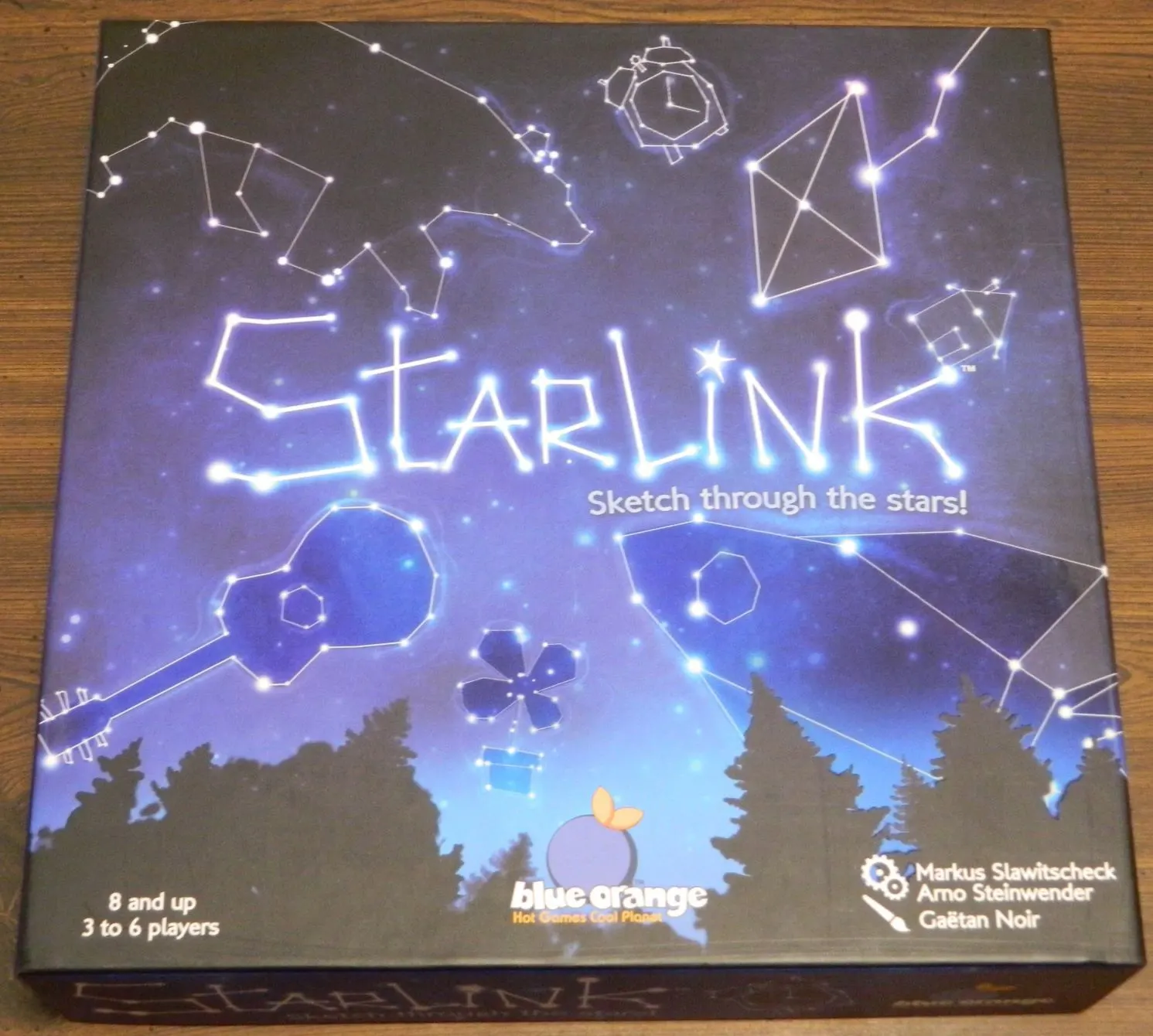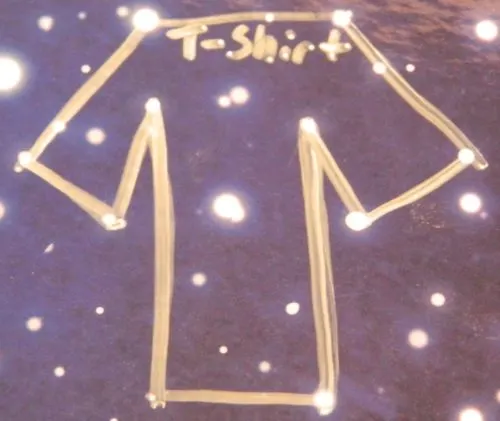Board games have utilized many different themes, but astronomy has always been one that hasn’t been used as much as I would have thought. There are a number of games that use a space theme, but it is used more for a setting than for the actual gameplay. Most space games that don’t just use it for a setting are more educational in nature so they generally aren’t all that interesting. While I have never been good at noticing constellations without assistance, constellations are an interesting premise for a board game that I have never really seen used. This is kind of surprising as I would think it would make for a great board game theme. Well today’s game Starlink does just that. One look at Starlink and it probably looks like what you would get if you combined Pictionary with the concept of constellations. In a way that is accurate. Starlink is not a perfect game, but it is an interesting twist on your typical party drawing game utilizing a connect the dots mechanic which leads to a surprisingly fun drawing game.
We would like to thank Blue Orange Games for the review copy of Starlink used for this review. Other than receiving the review copy we at Geeky Hobbies received no other compensation. Receiving the review copy had no impact on the content of this review or the final score.
How to Play Starlink
Setup
- Place the game board in the middle of the table.
- Shuffle all of the constellation cards and place them in a face down pile.
- Place the sand timer and telescope card near the game board.
- The player sitting closest to a window will be the first player. Play will then proceed clockwise.
Playing the Game
A player will begin their turn by taking the top constellation card. They will look at the card without letting the other players see it. The player will choose one of the two words to draw. When they have chosen one of the words they will flip over the timer and will begin drawing.
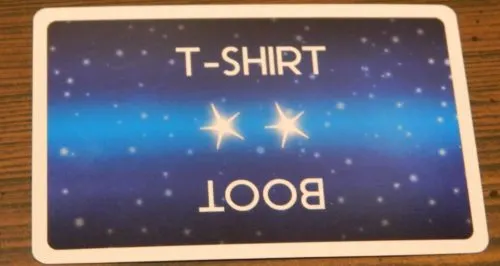
The current player drew this constellation card on their turn. They can choose to either draw a t-shirt or a boot.
When drawing a players must follows these rules:
- To draw you will connect the stars on the game board in a way that illustrates your word.
- When connecting stars you may only use straight lines.
- You can use as many stars on the board as you want in your drawing.
- Any star can be used whether is it bright or dim.
- Once a star has been used in a constellation it cannot be used in another constellation. You may connect multiple stars to the same star in a constellation though.
- If you make a mistake in your drawing you may erase part of what you have drawn. You may never erase parts of previously drawn constellations though. The only exception to this rule is if there is no room left to draw on the board. If there is not enough free space equal to the size of the telescope left on the board the current drawer can choose one of the constellations to erase.
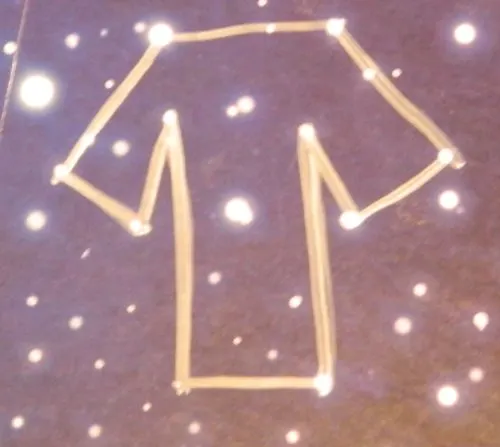
This player chose to draw a t-shirt. They have connected stars together with straight lines in the best way that they can to illustrate a t-shirt.
While the one player draws all of the other players are trying to figure out what they are drawing. When a player thinks they know what the player is trying to draw they will take the sand timer (making sure not to tip it). They will then say what their guess is.
If the player guessed correctly they and the drawer will receive points equal to the number of stars featured on the constellation card that was used for the round.
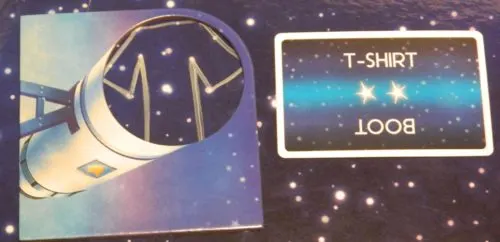
One of the players correctly guessed this player’s drawing. As the card shows two stars both players will receive two cards/points. As the picture doesn’t fully fit inside the telescope the players don’t receive the bonus point.
If the player is able to fit their entire constellation inside the telescope card both players will receive an additional point.
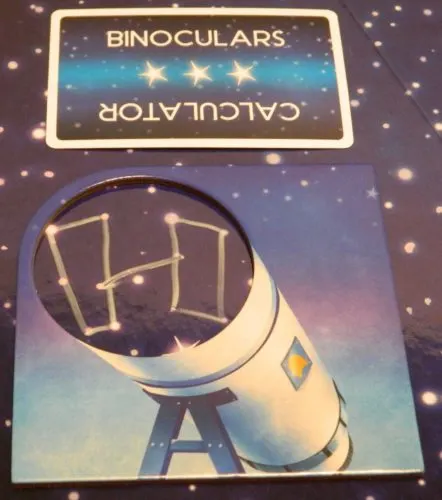
A player correctly guessed that this drawing was of binoculars. As the picture fit inside the telescope the players will receive three points/cards from the stars on the card as well as an additional point because the picture fit inside the telescope.
To represent points both players will take a number of constellation cards equal to the number of points that they have scored. The player who drew the constellation will write the name of the constellation next to it.
If the player guessed incorrectly the drawer will continue drawing. The player who guessed incorrectly is temporarily out of the game. The rest of the players can still guess. When the next player thinks they know the answer they will take the timer and submit their guess. If they are correct they will score points as mentioned above. If they are wrong they are now temporarily blocked from guessing. The first player to guess incorrectly can now start guessing again. This will continue until someone guesses correctly or time runs out. If time runs out the current drawer’s turn ends without anyone scoring any points. As no one guessed the constellation they will erase it.
Play will then pass to the next player clockwise who will become the next drawer.
End of Game
The game ends when each of the players has had the opportunity to draw twice. Each player will count up the cards they collected during the game. The player who collected the most cards wins the game. If there is a tie all of the tied players share the victory.
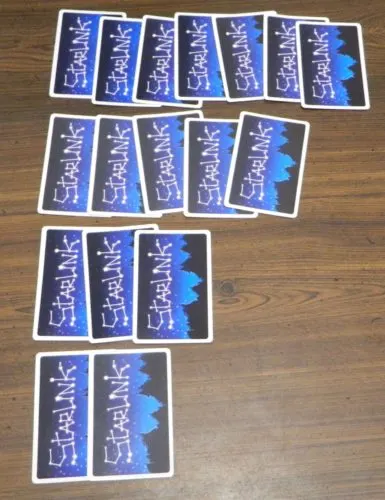
At the end of the game the players have acquired the following number of cards. As the top player acquired the most cards they have won the game.
My Thoughts on Starlink
I generally don’t like to jump to conclusions when I first see a new board game as I have been surprised by quite a few board games over the years. That said as soon as I saw Starlink I thought constellation Pictionary. It makes sense as it is obvious that Starlink takes inspiration from drawing games like Pictionary. When most people think of a party drawing game they will immediately go to Pictionary. Pictionary is a game that is loved by many while other people hate the game with a passion. I would personally say that I am somewhere in-between. Pictionary is pretty fun, but I wouldn’t consider myself an artist. Due to the success of Pictionary there are quite a few drawing games released every year. For this reason I am generally pretty picky when choosing games from this genre as too many games feel like just more of the same. I was intrigued by Starlink though as the premise of applying a drawing game to constellations was pretty intriguing.
In a lot of ways the title constellation Pictionary is pretty accurate when talking about Starlink. There really is no way to avoid this comparison when you make a party drawing game. Like every drawing game Starlink has you choose a card and then gives you a certain amount of time to draw what is shown on the card. If you draw well enough that another player can guess what you are drawing both you and the other player score points. There really isn’t any other way to do this type of game. This does mean though that your opinion of Starlink is going to depend on your opinion of party drawing games in general. If you have always hated Pictionary I don’t see that changing with Starlink. Those that love drawing games should love Starlink though.
For those in the middle like me though things become much more interesting. This is the aspect of Starlink that actually really surprised me. Despite sharing a lot in common with your typical drawing game Starlink actually feels like a unique experience. I attribute this to two things.
The first thing that changes the gameplay is the fact that you are drawing constellations. As constellations are formed by drawing straight lines between different stars this means that curved lines are banned in the game. I would be a little lenient on the straight line requirement within reason as some players can’t draw completely straight lines. Not being able to draw curves though has a significant impact on the game. Many of the objects in the game would be easy to draw if you had access to curves. Instead you need to use a set of straight lines to simulate curves. This takes some skill, but with some practice it is easier to draw a curved object with straight lines than you would think.
The other major difference in Starlink is the fact that there are limits on where you can draw. In most drawing games you can draw wherever you want. As you have to connect stars to draw your picture in Starlink though there are limits on where you can draw. This adds an interesting element to the game as you search for an area of the board that has stars placed in a way that will work with what you are trying to do. While there is a chance that you will pick the perfect location for your constellation, you more likely will have to adjust on the fly as you look for neighboring stars that somewhat work how you would want. You also have to deal with parts of the board already being used up by other constellations which forces you to work around other player’s drawings.
These two changes might not seem like they would add much to the game, but they actually do. In a lot of ways Starlink kind of feels like Pictionary meets connect the dots. You are basically trying to draw pictures by connecting various dots to form a picture. There is one main difference between Starlink and connect the dots though. In connect the dots you are given a picture with dots that are numbered so you know which dots to connect. In Starlink you are not given those numbers so you have to figure out how to make the connections yourself. This requires some planning and clever thinking in order to design an image on the fly using the dots on the gameboard. There is quite a bit of skill to figuring out the best way of connecting the various dots.
The comparison to connect the dots is not perfect, but I think it does a good job describing what it is like playing Starlink. Playing Starlink really feels like what you would get if you turned connect the dots into a party drawing game. I am not sure if there has been another game that has used this concept before, but it works surprisingly well in Starlink. There is just something about this connect the dots gameplay that is quite enjoyable.
Heading into Starlink one of the things that I was most worried about was the fact that I thought the game was going to be pretty difficult. I wasn’t worried about the game being hard to play as the mechanics are quite straightforward. You could probably teach the game to most players within just a couple minutes. The game has a recommended age of 8+ which might even be a little high. Outside of young children I see no one having trouble playing the game.
The reason I thought the game would be difficult is due to the fact that you had to draw pictures with straight lines utilizing the connect the dots mechanic. As no one in my group is what I would consider an artist I thought we would have a hard time drawing anything close to recognizable. I expected at max that we would get half of the drawings right. I was genuinely surprised that we did much better at the game than I was expecting. We got well over half of the drawings correct. This isn’t just because the words are really easy either as some can be quite difficult. I am not entirely sure why we did better at the game than I was expecting. For some reason having to use the connect the dots mechanic actually lead players to draw something that was surprisingly easy to guess. There were drawings that had no reason to lead to a correct answer and yet they did. It was really exciting when a player was able to get a correct guess when they thought they had no chance of getting one.
I think much of the difficulty that remains in the game comes from which constellation card you end up drawing. For the most part I think the game does a good job coming up with words that work with the connect the dots gameplay. There are some things though that you would have to be a true artist to be able to draw well with the other restrictions in place. This leads to the game relying on some luck due to what cards you draw. Some cards are considerably easier than others. With some cards being worth more than others this wouldn’t have been that big of an issue as the more valuable cards should be harder to draw. This is not always the case though as we encountered three star cards that were easier to draw than some two star cards. Therefore the winner is somewhat determined by who gets luckier with the cards that they draw. For this reason I would consider implementing a house rule where all of the constellation cards are separated by how many stars they have. Players could then choose whether they want an easier or harder word to draw. This could add a little strategy to the game and may eliminate some of the reliance on luck.
While drawing the objects was easier than I expected, fitting a drawing inside the telescope card is pretty difficult. Basically the telescope card rewards players for drawing well inside a small space. This is not that easy as you can’t fit a lot of lines inside the telescope. You should try for the bonus though as an additional point can be the difference between winning and losing. Some players will probably draw really large constellations, but the people I played with kept their constellations pretty small. They were rarely small enough to fit inside the telescope, but players didn’t tend to waste a bunch of space. Each player chose a section of the gameboard and mostly kept to that area of the board.
This fact lead to one of the problems that I had with Starlink. The game allows each player to draw twice. I am not sure exactly why the game settled on two turns as the game is more enjoyable with more rounds. With six players I could maybe see filling up quite a bit of the board after two rounds. If a player draws really large constellations it could fill up quickly as well. In one game (four players) though we played five or so rounds and we could have probably played another round or two and not ran out of space. While I like the larger board I kind of wish there was a little more competition for space on the board as I think it would have been interesting trying to work around the other players’ constellations. For this reason if you have less than six players I would highly recommend playing more than two rounds. This helps eliminate some of the luck from drawing a bad card and it is just more enjoyable playing more than two rounds. With four players and two rounds the game just seems to end too quickly.
Outside of basing the game mechanics off of it, I actually think Starlink does a good job utilizing the constellation mechanic. Many games use a space theme just for a setting, and yet it actually comes into use in the mechanics for Starlink. Many of the constellations that you will end up drawing will be silly, but it still feels like you are drawing constellations in the night sky. I attribute a lot of this to the game’s components. The components are quite good. I like the game’s artwork and it really embraces the theme. Drawing on the gameboard really feels like you are drawing on the night’s sky. The white marker against the dark sky makes the images really pop as you will want to look at all of your constellations at the end of the game. The board even erases well. The only complaint that I have with the components is that I wish it had more cards. A hundred cards should last quite a few games, but when you reuse the cards you likely will end up choosing the same object each time as one is usually easier to draw than the other. The good news is that I think you could easily take cards from similar drawing games and use them with Starlink should you ever get sick of the cards.
Should You Buy Starlink?
My first impression of Starlink was that it took the typical party drawing game and combined it with a connect the dots/constellation mechanic. In many ways that is exactly what it is. Many of the mechanics are similar to your typical party drawing game. The addition of the connect the dots mechanics where you have to connect stars together using straight lines actually surprised me though. The mechanic is pretty interesting as it requires some thought and planning to draw something that the other players can recognize. The game is easy to play where the whole family can enjoy it. Starlink does rely on some luck as some constellation cards are easier than others. The game also is on the shorter side where I would recommend playing more then the recommended number of rounds. Starlink doesn’t revolutionize the party drawing genre, but it does enough to create an interesting experience that families that are fans of drawing games should enjoy.
My recommendation depends on a couple factors. If you have always hated drawing games I see nothing in Starlink that will change your mind. If you generally like drawing games though and you think the premise behind the game sounds interesting, I think you will enjoy Starlink. I would recommend most people check out Starlink as it is a fun game.
Buy Starlink online: Blue Orange Games

